Curious what happens if you cut a cat's whiskers? Find out the role of whiskers in cats and other animals and what would happen if they would lose them.
Since you are reading this article, you probably wonder what would happen if you cut or shortened your cat's whiskers. Would that influence the cat's behavior in any way, and most importantly, would that hurt the animal? Or do whiskers only have a decorative purpose?
To give you a short answer:
For a more detailed answer and to find out the role of whiskers in cats and other animals, keep reading.
What are whiskers?
Although we commonly call these hairs "whiskers," in scientific terms, they are known as tactile hairs or vibrissae. The name "vibrissae" comes from the Latin word "vibrio," which means "to vibrate."
Not everything is known about the exact role of whiskers, but certainly, these special types of hairs do not have solely an ornamental role.
Besides cats, many animals also possess some type of whiskers, but the most common are facial whiskers. In fact, except for humans and great apes, all mammals have them.
While whiskers are unquestionably widespread among mammals, other terrestrial and aquatic creatures have them in a shape or another — fish, turtles, sharks, etc.

In fish, they are called barbels and are usually made of ossified or cartilaginous connective tissue. Species such as catfish, carp, sturgeon, zebrafish, and countless others have them. [1]
In mammals, whiskers are made of the same thing as hair; a protein called keratin. However, several particularities set them apart from ordinary hairs.
Whiskers are longer, thicker, and tougher than regular hairs. Each one is anchored into the skin by something called a follicle. The follicles of whiskers are found deeper under the skin than ordinary hairs and have more nerves.
Cats' whiskers grow on either side of their nostrils, on the chin, above eyes, and on the back of their front legs.

If you didn't know, find out that cats also possess a few whiskers on the back of their front limbs called carpal whiskers. They are located just near the cat's leg wrist but sometimes are hard to spot due to their isolated position and the fur that masks them pretty well. So, many cat owners have no idea that their pets also have these additional pairs.
The most important pairs of whiskers are the ones on the cheeks. These are the largest whiskers and are approximately as long as the width of a cat's body. Although it may vary from one breed to another, most cats usually have 12 whiskers distributed on 4 rows on each cheek. [2]
Role of whiskers in cats and other animals
It is believed that different animals use their whiskers in different ways. For some species, these antenna-like hairs are more important than for others, but their existence indicates that whiskers are still playing at least a role for all of them. Most mammals, including cats, are also able to move their whiskers.
For cats, as well as for most mammals, whiskers' main role is to help the animal navigate throughout its environment. It is believed that they help the animal to estimate the size of spaces, approximate the shape and distances to objects, and as a collision detector. They are also used for hunting, social interaction and helps the animal's movement in the dark.
Basically, whiskers help the animal explore its environment providing an enhancement to the eyesight. We can compare one of their roles to a lesser extent to humans' tactile sense, which gives us an extra view of what's around us.
Our touching sense works with the help of several types of receptors in our skin that collect information such as an object's vibration, pressure, temperature, stiffness, etc. These directions are then transmitted to the brain through our nervous system and help us make an idea about an object even if we can't see it.
Although cat whiskers' functions are notably different than our skin's tactile sense, they carry some of these roles.
Cats also use their whiskers during hunting to detect the vibrations in the air caused by the movement of the prey. This helps the felines anticipate movements at high speeds and attack with extraordinary accuracy.
The importance of a cat's whiskers in hunting is also highlighted in the following slow-motion footage of BBC Earth's YouTube channel.
So, one of the first consequences of cutting your cat's whiskers would be disorientation. The animal would lose a part of its ability to approximate spaces and shapes correctly, and you would probably often see it running into objects or getting stuck in small places.
Furthermore, your cat may also start having issues catching its prey, unable to feel the vibrations caused in the air by its movement due to its missing whiskers.
Additionally, studies have shown that many small mammals, like rodents, use their whiskers to tactually guide safe foot positioning. Guiding locomotion and environment exploration are, hence, two of the most common functions of whisker touch sensing in small non-flying mammals. [3]
Do whiskers grow back?
Animals can lose their whiskers for various reasons. For instance, the animal can damage its whiskers very easily when approaching a heat source or can break them in a battle with another animal.
Also, as they are actually hairs, it's perfectly normal for whiskers to fall out on their own from time to time. However, they are normally replaced gradually so the animal won't lose all its whiskers overnight.
Most mammals' whiskers grow back, and although this takes some time, the whiskers will eventually return.
Final Word
Now you know what would happen if you cut a cat's whiskers. Hopefully, this article has helped you to realize the value of these antenna-like hairs in the behavior of animals, as well as why you should never trim or shave your pet's whiskers.
Cats also can get aggressive if you play with their whiskers as this area is very sensitive. So, it's better to avoid messing with a cat's whiskers in any way.



